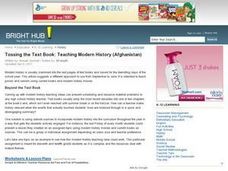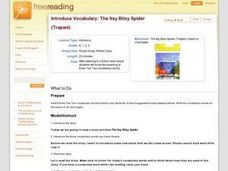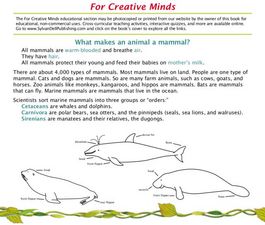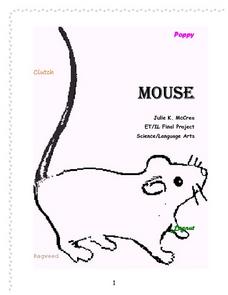Curated OER
Spider Activities, Experiments and Projects
Learners examine seven spiders and put them into two or three groups based on their structural similarities. In groups, they create a cladogram proposing possible ancestral relationships. Students design an experiment related to their...
Curated OER
What In The World Are Swim Bladders and Why Are They Important
In this swim bladders worksheet, students use a bowl, water, and balloons to make swim bladders, and answer short answer questions about them. Students answer 7 questions and interview someone who has been scuba diving.
Curated OER
Anty-Bodies
Students compare and contrast likenesses and differences to others by creating a life-size picture of themselves. In this character building lesson, students dictate a sentence about comments on sharing and display them with their...
Curated OER
Coastal Threat: A Story in Unit Conversions
Students convert measurements from one unit to another. In this math lesson, students study the environmental consequences of oil spills. They replicate an oil spill event by modeling and scaling.
Curated OER
How 'Bout Them Apples?
Students recognize the short vowel a in written and spoken language. Through matching activities, they discriminate the short vowel /a/ from other phonemes. Students associate the phoneme with its letter representation in words and phrases.
Curated OER
Tossing the Text Book: Teaching Modern History
Tenth graders analyze primary sources. In this Current Events instructional activity, 10th graders write a short two - three paged paper answering a specific question. Students prepare a fact sheet for the class detailing...
Curated OER
EasyData Reference
Learners explore the EasyData. In this secondary mathematics lesson plan, students investigate the screens, menus, and list of types of data collection available with the EasyData.
Curated OER
A Picture is Worth a Thousand Words - The Caldecott Award
Students engage in a variety of activities as they study illustrators, how illustrations enhance a studenT book, and the Caldecott Award. They write a report about their favorite illustrator.
Curated OER
Fahrenheit 451: Social Criticism
Students write a four paragraph essay that tells about two things in society that Ray Bradbury criticizes in the book, Fahrenheit 451. In this social criticism lesson, students develop a thesis based on their reading of the book and...
Curated OER
4-Digit Problem Solving: Add and Subtract
In this problem solving worksheet, students solve a total of 7 equations, drawing models and using algorithm. A reference web site for additional activities is given.
Curated OER
Perception is Not Always Reality
Pupils view various types of illusions. Using one of the illusions, they try to determine how a scientist might explain them. They discover a t-illusion and use their own words to analyze them. In groups, they research a different solution.
Curated OER
A Fresh Twist on Fabric Folding
Students practice different ways to fold fabric. Using different types of fabrics, they create 3D fabric models to be used in quilts or clothing. They share their designs with the class and critique their classmates design.
Curated OER
Environment" The Mining Cycle
Students explore the world of mining and explain its importance in daily life. After describing how companies search for mineral deposits, they examine the environmental consequences of mining as well as the positive aspects. The...
Curated OER
Water, Glorious Water
Students identify the various uses of water. In this water conservation lesson, students read the book, The Drop In My Drink: The Story of Water On Our Planet and write down their favorite uses of water. Students illustrate how they can...
Curated OER
Trout Life-Cycle Booklet
Students write books about trout, completing one page per life stage.
Curated OER
Introduce Vocabulary: Curious George Rides a Bike
Students explore language arts by reading a classic book in class. In this story vocabulary lesson, students read the book Curious George Rides a Bike and identify the use of specific vocabulary words. Students define the selected words...
Curated OER
Introduce Vocabulary: The Circus is Coming
Students explore language arts by reading a story book in class. In this tier two vocabulary lesson, students read the book The Circus is Coming and identify the use of specific vocabulary words. Students define the selected vocab words...
Curated OER
Introduce Vocabulary: The Great Kapok Tree
Students explore language arts by reading a children's book in class. In this tier two vocabulary lesson, students read the book The Great Kapok Tree and identify the use of vocabulary terms. Students define the selected vocab words and...
Curated OER
Introduce Vocabulary: The Itsy Bitsy Spider
Students explore language arts by reading a children's book in class. In this story vocabulary lesson, students read the book The Itsy Bitsy Spider and identify the use of specific vocabulary words. Students define the selected vocab...
Curated OER
For Creative Minds: What Makes an Animal a Mammal?
Students read about categories of mammals and their features. Students then construct a marine animal, using given print outs in the lesson. Students then create adaptations for their mammal, using a web site reference for guidance.
Curated OER
The Ice Cream Shop
Second graders read books about ice cream and plan an ice cream sundae party for the class. They research ingredients and determine how much the party cost each student. They hold a mock opening for an ice cream store and have their party.
Curated OER
The Little House
First graders read the story "The Little House" and discuss changing patterns and then create a seasonal mandala using a paper plate and crayons.
Curated OER
Mouse
First graders are exposed to a variety of texts that deal with mice. The use of the library is recommended to saturate the classroom with available books. Young students work in groups with the help of the teacher to define traits and...
Curated OER
Ancient China: Student Created Word Search Puzzles
Sixth graders classify and organize information about ancient China. In this Chinese history lesson, 6th graders create word search puzzles and record the processes they used to create them.























